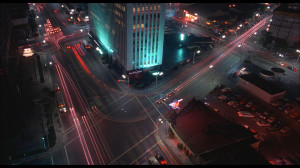Koyaanisqatsi (1981, 1982, directed by Godfrey Reggio) represents more of a visual essay, one of the few documentaries that we can describe as holistic. It can be interpreted as a spiritual travelogue through our past, present and future. In its symmetrical ends, like in the cover of a volume, the film encloses its very essence. Even though it premiered in the early eighties, it still remains true to its message in modern times, like a testimony of our passage on Earth as humans.
The ideological pretext of the film lies with the Hopi Prophecies. However the film has the good taste not to exploit the spectacularly visual side of their ancestors, the Anasazi. So, no Mesa Verde, no Hovenweep Castle, Moctezuma’s Palace or Pueblo Aztec. The film rests on the sole power of images about mankind, collected in the space of eight years (1973-1980), some by Reggio’s team (cinematographer Ron Fricke), some from miscellaneous sources.
It plunges us, the viewers, into the voyage from dust to mankind and back. The traditional partition of fire – water – earth – wind is respected and recognizable in the first part of the flick. Each chapter offers warnings on our condition and course of life, some delivered in subtle bits of montage: the dry stone peak from Monument Valley is mirrored in a correspondent monolith, this time man-made, from glass and stone; the dessert, filmed from the plane, dotted with rock hills, resemble the aerial vista of a soon to be demolished and equally deserted neighborhood. The travel through the steep walls of a canyon is matched by a similar camera movement, this time through a street narrowed by equally steep skyscrapers; and the satellite view of a modern metropolis is followed, in a direct cut, by the image of a silicon chip, which almost identically resembles the city grid.
The “robotisation” of human society, although in its infancy when the film premiered, is caught in glimpses of time lapse footage, while a beautiful Hopi hymn accompanies the sequences that could be titled “To the lone man”. It’s this amazing site of human solitude in the middle of the hustle and bustle of the human megalopolis that speaks volumes in the space of a few minutes. This is not the only feat of innovation the documentary comes with. Philip Glass’s soundtrack became legendary and the technical stunts of the film - like the time lapse or the slow motion - are now routine.
The haunting sequences stay with you long after the film ends. Such is the demolition of the neighborhood, the image of careless sunbathers with the nuclear plant in the background. Such is the moon traveling to the back of a skyscraper, and many more.
As they say, Finis coronat opus (the end justifies the means) - in this case, the film’s ending, circular as it is, encapsulates a whole metaphor about mankind, our loneliness (again!) as a human race, and our very own fragility.






